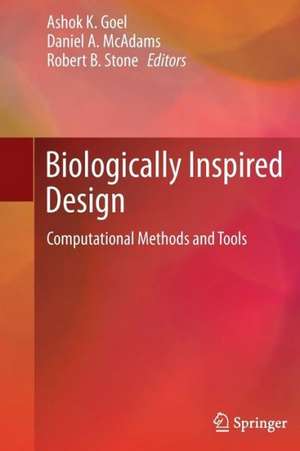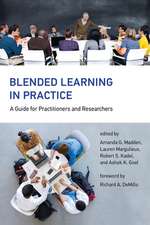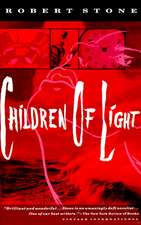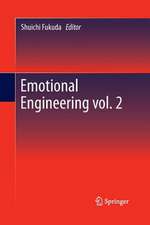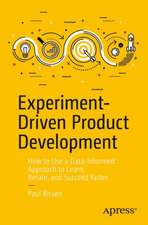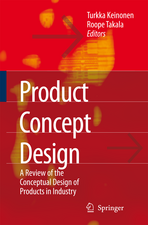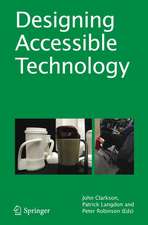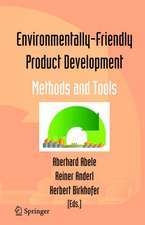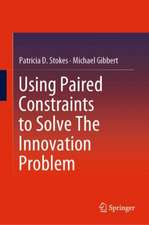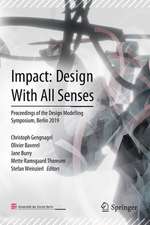Biologically Inspired Design: Computational Methods and Tools
Editat de Ashok K. Goel, Daniel A McAdams, Robert B. Stoneen Limba Engleză Hardback – 29 iul 2013
With an inspiring foreword from Janine Benyus, Biologically Inspired Design contains a dozen chapters written by some of the leading scholars in the transdisciplinary field of bioinspired design, such as Frank Fish, Julian Vincent and Jeannette Yen from biology, and Amaresk Chakrabarti, Satyandra Gupta and Li Shu from engineering. Based in part on discussions at two workshops sponsored by the United States National Science Foundation, this volume introduces and develops several methods and tools for bioinspired design including:
Information-processing theories,
Natural language techniques,
Knowledge-based tools, and
Functional approaches and Pedagogical techniques.
By exploring these fundamental theories, techniques and tools for supporting biologically inspired design, this volume provides a comprehensive resource for design practitioners wishing to explore the paradigm, an invaluable guide to design educators interested in teaching the method, and a preliminary reading for design researchers wanting to investigate bioinspired design.
| Toate formatele și edițiile | Preț | Express |
|---|---|---|
| Paperback (1) | 946.72 lei 6-8 săpt. | |
| SPRINGER LONDON – 9 aug 2015 | 946.72 lei 6-8 săpt. | |
| Hardback (1) | 946.72 lei 6-8 săpt. | |
| SPRINGER LONDON – 29 iul 2013 | 946.72 lei 6-8 săpt. |
Preț: 946.72 lei
Preț vechi: 1154.54 lei
-18% Nou
Puncte Express: 1420
Preț estimativ în valută:
181.18€ • 188.45$ • 149.57£
181.18€ • 188.45$ • 149.57£
Carte tipărită la comandă
Livrare economică 14-28 aprilie
Preluare comenzi: 021 569.72.76
Specificații
ISBN-13: 9781447152477
ISBN-10: 1447152476
Pagini: 344
Ilustrații: XVIII, 325 p.
Dimensiuni: 155 x 235 x 24 mm
Greutate: 0.48 kg
Ediția:2014
Editura: SPRINGER LONDON
Colecția Springer
Locul publicării:London, United Kingdom
ISBN-10: 1447152476
Pagini: 344
Ilustrații: XVIII, 325 p.
Dimensiuni: 155 x 235 x 24 mm
Greutate: 0.48 kg
Ediția:2014
Editura: SPRINGER LONDON
Colecția Springer
Locul publicării:London, United Kingdom
Public țintă
ResearchCuprins
1.Introduction.- 2.The AskNature Database: Enabling Solutions in Biomimetic Design.- 3.A Natural Language Approach to Biomimetic design.- 4.A Thesaurus for Bioinspired Engineering Design.- 5.Function-Based Bioinspired Design.- 6.Information-Processing Accounts of Biologically Inspired Sustainable Design.- 7.Evolution of Undergraduate Biologically Inspired Design Course.- 8.Supporting Analogical Transfer in Biologically Inspired Design.- 9.Overcoming Cognitive Challenges in Bioinspired Design and Analogy.- 10.Bioinspiration in Robotics: A Design-Control-Manufacturing Perspective.- 11.Finding the gaps for BID.- 12.Evolution and Bio-inspired Design: Natural Limitations
Notă biografică
Dr. Ashok K. Goel is a Professor of Computer and Cognitive Science in the School of Interactive Computing at Georgia Institute of Technology in Atlanta, USA. He is the Director of the School's Design & Intelligence Laboratory, and a Co-Director of the Institute’s Center for Biologically Inspired Design. He serves on the Boards of the Biomimicry 3.8 Institute and the BioInspired! digital magazine. Ashok conducts research into artificial intelligence, cognitive science and human-centered computing, with a focus on computational design, modeling and creativity. His research explores analogical thinking, systems thinking, visual thinking, and meta-thinking as fundamental processes of design and creativity. Ashok’s current research investigates analogical and systems thinking in biologically inspired engineering design, analogical and visual thinking on intelligence tests, and systems and meta-thinking in game-playing agents. In related research, he uses theories of analogical and systems thinking for supporting learning about ecological systems in middle school science and biological systems in college-level education in biologically inspired design. Ashok’s 2013 TEDx <http://www.youtube.com/watch?v=wiRDQ4hr9i8> summarizes some of his research on biologically inspired design. An interactive tool for supporting some aspects of biologically inspired design developed by his laboratory is available at <http://dilab.cc.gatech.edu/dane/>.
Dr. Daniel A. McAdams is currently an associate professor Department of Mechanical Engineering at Texas A&M University. His research interests are in the area of design theory and methodology with specific focus on functional modeling; innovation in concept synthesis; biologically inspired design methods; inclusive design; and technology evolution as applied to product design. Dr. McAdams leads the Product SynthesisEngineering Lab (http://www.prosedesign.org/). He has served in various scholarly leadership roles including Technical Committee Chair for ASME Design Theory and Methodology Committee and serving on the editorial board of the Journal of Engineering Design. Dr. McAdams served as an associate and assistant professor at the Missouri University of Science and Technology. He received his PhD from the University of Texas at Austin.
Dr. Robert B. Stone is a Professor and the Interim Head of the School of Mechanical, Industrial and Manufacturing Engineering at Oregon State University. Dr. Stone’s research interests include design theories and methodologies, specifically automated conceptual design techniques and concept generation techniques such as biologically inspired design. He has authored chapters on product architecture and reverse engineering techniques in product design texts. He leads the Design Engineering Lab (designengineeringlab.org). Previously, Stone utilized his design background to assist in creating the design-focused Interdisciplinary Engineering degree program at the University of Missouri-Rolla. At Rolla he served as Director of the interdisciplinary Student Design and Experiential Learning Center from January 2004 throughJune 2008 where he oversaw the design competition activities of ten teams and guided the Center’s new engineering design and experiential learning initiative. He was a Distinguished Visiting Professor at the US Air Force Academy during the 2006-07 academic year. Prior to initiating his graduate work, Dr. Stone worked in the Missions Operation Directorate of NASA-Johnson Space Center as a Space Shuttle Flight Controller for the Guidance, Navigation and Control Section. Stone completed his PhD in Mechanical Engineering from The University of Texas atAustin.
Dr. Daniel A. McAdams is currently an associate professor Department of Mechanical Engineering at Texas A&M University. His research interests are in the area of design theory and methodology with specific focus on functional modeling; innovation in concept synthesis; biologically inspired design methods; inclusive design; and technology evolution as applied to product design. Dr. McAdams leads the Product SynthesisEngineering Lab (http://www.prosedesign.org/). He has served in various scholarly leadership roles including Technical Committee Chair for ASME Design Theory and Methodology Committee and serving on the editorial board of the Journal of Engineering Design. Dr. McAdams served as an associate and assistant professor at the Missouri University of Science and Technology. He received his PhD from the University of Texas at Austin.
Dr. Robert B. Stone is a Professor and the Interim Head of the School of Mechanical, Industrial and Manufacturing Engineering at Oregon State University. Dr. Stone’s research interests include design theories and methodologies, specifically automated conceptual design techniques and concept generation techniques such as biologically inspired design. He has authored chapters on product architecture and reverse engineering techniques in product design texts. He leads the Design Engineering Lab (designengineeringlab.org). Previously, Stone utilized his design background to assist in creating the design-focused Interdisciplinary Engineering degree program at the University of Missouri-Rolla. At Rolla he served as Director of the interdisciplinary Student Design and Experiential Learning Center from January 2004 throughJune 2008 where he oversaw the design competition activities of ten teams and guided the Center’s new engineering design and experiential learning initiative. He was a Distinguished Visiting Professor at the US Air Force Academy during the 2006-07 academic year. Prior to initiating his graduate work, Dr. Stone worked in the Missions Operation Directorate of NASA-Johnson Space Center as a Space Shuttle Flight Controller for the Guidance, Navigation and Control Section. Stone completed his PhD in Mechanical Engineering from The University of Texas atAustin.
Textul de pe ultima copertă
From simple cases such as hook and latch attachments found in Velcro to articulated-wing flying vehicles, biology often has been used to inspire many creative design ideas. The scientific challenge now is to transform the paradigm into a repeatable and scalable methodology. Biologically Inspired Design explores computational techniques and tools that can help integrate the method into design practice.
With an inspiring foreword from Janine Benyus, Biologically Inspired Design contains a dozen chapters written by some of the leading scholars in the transdisciplinary field of bioinspired design, such as Frank Fish, Julian Vincent and Jeannette Yen from biology, and Amaresk Chakrabarti, Satyandra Gupta and Li Shu from engineering. Based in part on discussions at two workshops sponsored by the United States National Science Foundation, this volume introduces and develops several methods and tools for bioinspired design including:
Information-processing theories,
Natural language techniques,
Knowledge-based tools, and
Functional approaches and Pedagogical techniques.
By exploring these fundamental theories, techniques and tools for supporting biologically inspired design, this volume provides a comprehensive resource for design practitioners wishing to explore the paradigm, an invaluable guide to design educators interested in teaching the method, and a preliminary reading for design researchers wanting to investigate bioinspired design.
With an inspiring foreword from Janine Benyus, Biologically Inspired Design contains a dozen chapters written by some of the leading scholars in the transdisciplinary field of bioinspired design, such as Frank Fish, Julian Vincent and Jeannette Yen from biology, and Amaresk Chakrabarti, Satyandra Gupta and Li Shu from engineering. Based in part on discussions at two workshops sponsored by the United States National Science Foundation, this volume introduces and develops several methods and tools for bioinspired design including:
Information-processing theories,
Natural language techniques,
Knowledge-based tools, and
Functional approaches and Pedagogical techniques.
By exploring these fundamental theories, techniques and tools for supporting biologically inspired design, this volume provides a comprehensive resource for design practitioners wishing to explore the paradigm, an invaluable guide to design educators interested in teaching the method, and a preliminary reading for design researchers wanting to investigate bioinspired design.
Caracteristici
Outlines the state of the art in bioinspired design methods and the outstanding research questions in the field thus clarifying what can be done, what can be done, and what needs to be done Contains contributions by a diverse set of leaders in the field that provide existing methods to conduct bio-inspired design Provides detailed, specific, and formal methods for how to use nature as inspiration for engineering design thus enabling the design practitioner to apply such methods to their design problems Includes chapter relevant URLs, examples and a range of figures an diagrams to illustrate and explain methods and their design and research applications Includes supplementary material: sn.pub/extras
